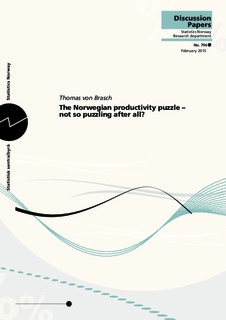The Norwegian productivity puzzle - not so puzzling after all?
| dc.contributor.author | von Brasch, Thomas | |
| dc.coverage.spatial | Norway | nb_NO |
| dc.date.accessioned | 2019-11-11T10:13:48Z | |
| dc.date.available | 2019-11-11T10:13:48Z | |
| dc.date.issued | 2015-02 | |
| dc.identifier.issn | 1892-753X | |
| dc.identifier.uri | http://hdl.handle.net/11250/2627641 | |
| dc.description.abstract | The Norwegian productivity puzzle is rooted in three seemingly contradictory “facts”: First, Norway is one of the most productive OECD countries. Second, Norway has experienced high growth in productivity. Third, Norway has a relatively low level of R&D intensity. In this article, I show that the first premise of the puzzle is probably false. Explicitly, I demonstrate that labour productivity in Norway is not particularly high when using production purchasing power parities instead of expenditure purchasing power parities to measure mainland GDP in a common currency. The gap between the two measures is traced back to the use of market exchange rates as proxies for relative net export prices in the calculation of expenditure PPPs. In addition, I show that the high growth rate in productivity can be explained by an empirical growth model that takes both R&D capital, human capital and the distance to the technological frontier into account. Based on these results, there is no reason to claim that the development of productivity in Norway represents a puzzle. | nb_NO |
| dc.language.iso | eng | nb_NO |
| dc.publisher | Statistisk sentralbyrå | nb_NO |
| dc.relation.ispartofseries | Discussion papers;796 | |
| dc.subject | JEL classification: C43 | nb_NO |
| dc.subject | JEL classification: E01 | nb_NO |
| dc.subject | JEL classification: E31 | nb_NO |
| dc.subject | JEL classification: O47 | nb_NO |
| dc.subject | JEL classification: O57 | nb_NO |
| dc.title | The Norwegian productivity puzzle - not so puzzling after all? | nb_NO |
| dc.type | Working paper | nb_NO |
| dc.description.version | publishedVersion | nb_NO |
| dc.subject.nsi | VDP::Matematikk og Naturvitenskap: 400::Matematikk: 410::Statistikk: 412 | nb_NO |
| dc.source.pagenumber | 33 | nb_NO |
Tilhørende fil(er)
Denne innførselen finnes i følgende samling(er)
-
Discussion Papers [1002]
